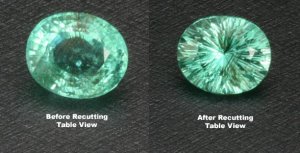Daisi2112
Shiny_Rock
- Joined
- Jan 5, 2009
- Messages
- 356
Date: 4/30/2009 9:11:38 AM
Author: Chrono
Very differently from diamonds. Coloured stones are all about colour and there is no grading for cut. Even within colour, there are a lot of nuances. Most labs will only state the colour but AGTA and AGL will give more details about brilliance, undertone, etc if you get the full lab cert.

Date: 4/30/2009 10:29:09 AM
Author: Daisi2112
Date: 4/30/2009 9:11:38 AM
Author: Chrono
Very differently from diamonds. Coloured stones are all about colour and there is no grading for cut. Even within colour, there are a lot of nuances. Most labs will only state the colour but AGTA and AGL will give more details about brilliance, undertone, etc if you get the full lab cert.
So if there is no grading for cut, how do you know you're buying a really good quality colored stone? Are there certain cuts that just look good with certain colored stones? Sorry, I'm so confused!


I once saw some cabochon demantoid and sphene. That is a waste of good RI (refractive index).Date: 4/30/2009 5:29:33 PM
Author: tourmaline_lover
That''s so true Chrono. For example, cabachons aret are not faceted at all, but are used to display pure color. Can you imagine a cabachon diamond?Diamonds are really known for their amazing refractive properties, so to take advantage of that, cutting is probably one of the most important things to consider. I have some poorly cut colored gems with great color, and the cutting doesn''t bother me as much because it''s all about the color.

I agree with that statement. I have seen some well cut gems with mediocre colour and some good native cutting with superb colour. Personally, I prefer to get an excellently coloured gemstone with above average cutting. It doesn''t need to be precision cut but it must have a good outline, no windows, little extinction, something not lopsided, centered culet, ...you get the idea.Date: 4/30/2009 10:51:17 PM
Author: PrecisionGem
Of course you all knew I would pipe in and disagree.
Cutting is very important in colored stones. In R.W. Wise''s book, he says; ''there are many well cut stones that are not ''gems'', but there are NO ''gems'' that are not well cut.''
A well cut stone, all other things being equal will be more beautiful, and will sell for a higher price, and be more rare. For every thousand of poorly cut stones, there is maybe 1 well cut one. The more unique cuts, attract the more unique jeweler, who make the more unique, one of kind (expensive) piece of jewelry.
How many times on Pricescope have we heard someone who bought a stone from one of the US cutters say ''wow, it sparkles so much'' or something along those lines. They are comparing these well cut stones, to the other commercial cut stones, and see a difference. I have seen a few stones posted here that are recuts, and the difference is dramatic. Some guys make a living buying cut stones and recutting. Even though the finished stone is smaller, they are selling them for a higher price. Why? It''s because of the added beauty of the better cut.


